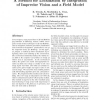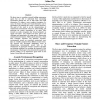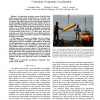246 search results - page 40 / 50 » Navigating Mobile Robots: Sensors and Techniques |
ETFA
2008
IEEE
14 years 3 months ago
2008
IEEE
This paper presents a localization system for mobile robots that are able to navigate autonomously in industrial environments like factory and exhibition halls. Previous approache...
ICRA
2010
IEEE
13 years 7 months ago
2010
IEEE
—In many robotics applications, knowing the material properties around a robot is often critical for the robot’s successful performance. For example, in mobility, knowledge abo...
ROBOCUP
1999
Springer
14 years 1 months ago
1999
Springer
In recent years, many researchers in AI and Robotics pay attention to RoboCup, because robotic soccer games needs various techniques in AI and Robotics, such as navigation, behavi...
AAAI
2008
13 years 11 months ago
2008
My thesis aims to contribute towards building autonomous agents that are able to understand their surrounding environment through the use of both audio and visual information. To ...
ICRA
2009
IEEE
14 years 3 months ago
2009
IEEE
— In cooperative navigation, teams of mobile robots obtain range and/or angle measurements to each other and dead-reckoning information to help each other navigate more accuratel...



